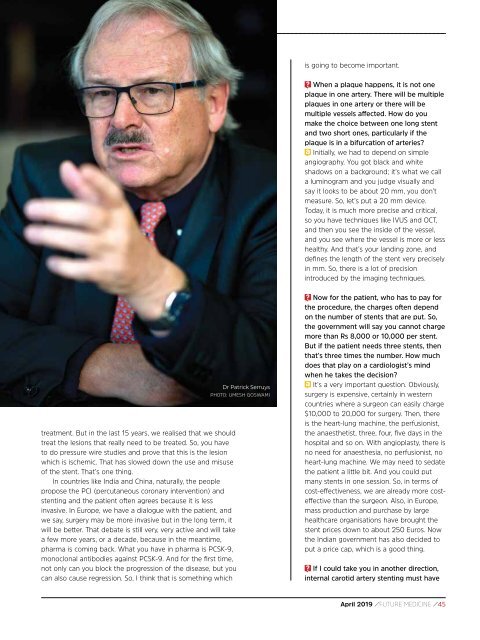Create successful ePaper yourself
Turn your PDF publications into a flip-book with our unique Google optimized e-Paper software.
is going to become important.<br />
When a plaque happens, it is not one<br />
plaque in one artery. There will be multiple<br />
plaques in one artery or there will be<br />
multiple vessels affected. How do you<br />
make the choice between one long stent<br />
and two short ones, particularly if the<br />
plaque is in a bifurcation of arteries?<br />
Initially, we had to depend on simple<br />
angiography. You got black and white<br />
shadows on a background; it’s what we call<br />
a luminogram and you judge visually and<br />
say it looks to be about 20 mm, you don’t<br />
measure. So, let’s put a 20 mm device.<br />
Today, it is much more precise and critical,<br />
so you have techniques like IVUS and OCT,<br />
and then you see the inside of the vessel,<br />
and you see where the vessel is more or less<br />
healthy. And that’s your landing zone, and<br />
defines the length of the stent very precisely<br />
in mm. So, there is a lot of precision<br />
introduced by the imaging techniques.<br />
treatment. But in the last 15 years, we realised that we should<br />
treat the lesions that really need to be treated. So, you have<br />
to do pressure wire studies and prove that this is the lesion<br />
which is ischemic. That has slowed down the use and misuse<br />
of the stent. That’s one thing.<br />
In countries like India and China, naturally, the people<br />
propose the PCI (percutaneous coronary intervention) and<br />
stenting and the patient often agrees because it is less<br />
invasive. In Europe, we have a dialogue with the patient, and<br />
we say, surgery may be more invasive but in the long term, it<br />
will be better. That debate is still very, very active and will take<br />
a few more years, or a decade, because in the meantime,<br />
pharma is coming back. What you have in pharma is PCSK-9,<br />
monoclonal antibodies against PCSK-9. And for the first time,<br />
not only can you block the progression of the disease, but you<br />
can also cause regression. So, I think that is something which<br />
Dr Patrick Serruys<br />
PHOTO: UMESH GOSWAMI<br />
Now for the patient, who has to pay for<br />
the procedure, the charges often depend<br />
on the number of stents that are put. So,<br />
the government will say you cannot charge<br />
more than Rs 8,000 or 10,000 per stent.<br />
But if the patient needs three stents, then<br />
that’s three times the number. How much<br />
does that play on a cardiologist’s mind<br />
when he takes the decision?<br />
It’s a very important question. Obviously,<br />
surgery is expensive, certainly in western<br />
countries where a surgeon can easily charge<br />
$10,000 to 20,000 for surgery. Then, there<br />
is the heart-lung machine, the perfusionist,<br />
the anaesthetist, three, four, five days in the<br />
hospital and so on. With angioplasty, there is<br />
no need for anaesthesia, no perfusionist, no<br />
heart-lung machine. We may need to sedate<br />
the patient a little bit. And you could put<br />
many stents in one session. So, in terms of<br />
cost-effectiveness, we are already more costeffective<br />
than the surgeon. Also, in Europe,<br />
mass production and purchase by large<br />
healthcare organisations have brought the<br />
stent prices down to about 250 Euros. Now<br />
the Indian government has also decided to<br />
put a price cap, which is a good thing.<br />
If I could take you in another direction,<br />
internal carotid artery stenting must have<br />
<strong>April</strong> <strong>2019</strong> / FUTURE MEDICINE / 45


















